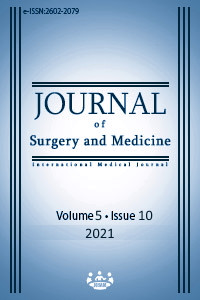The relationship between atherogenic index and coronary collateral circulation
Keywords:
Cholesterol, Coronary arteries, Atherosclerosis, Collateral circulationAbstract
Background/Aim: The atherogenic index of plasma (AIP) is a simple and useful biomarker that can predict plasma atherogenicity and coronary artery disease (CAD). Previous studies showed a relationship between AIP with CAD. Therefore, we researched the relationship between the AIP and coronary collateral circulation (CCC) in patients with chronic coronary total occlusion (CTO). Methods: Three hundred and twenty patients who underwent coronary angiography with the diagnosis of stable or unstable angina pectoris between 2015 and 2019 and who had CTO in at least one coronary artery were included in this retrospective study. The AIP was calculated as the logarithm of [Triglyceride (mg/dL) / high-density lipoprotein cholesterol (mg/dL)]. CCC was graded per the Rentrop grading system in patients with CTO after coronary angiography. Rentrop grades were as follows: 0-1: Low-grade (Group 1) CCC, 2-3: High-grade CCC (Group 2). Results: There were 170 and 150 patients in Groups 1 and 2, respectively, with the mean ages of 63.5 (9.5) years and 61.1 (10.1) years. Mean body mass index, left ventricular ejection fraction, the rate of hypertension, and smoking were similar between the two groups. The rate of diabetes mellitus (DM) was higher in Group 1 (P=0.006). Multivariate analysis showed that AIP (OR: 4.357, CI 95%: 2.741-6.335, P<0.001) and DM (OR: 0.893, CI 95%: 0.826-0.966, P=0.015) were independent predictors of poor CCC. Conclusion: In our study, we found that a high AIP is related to poor coronary collateral circulation.
Downloads
References
Råmunddal T, Hoebers LP, Henriques JP, Dworeck C, Angerås O, Odenstedt J, et al. Chronic total occlusions in Sweden--a report from the Swedish Coronary Angiography and Angioplasty Registry (SCAAR). PLoS One. 2014;9(8):e103850.
Stojkovic S, Juricic S, Dobric M, Nedeljkovic MA, Vukcevic V, Orlic D, et al. Improved Propensity-Score Matched Long-Term Clinical Outcomes in Patients with Successful Percutaneous Coronary Interventions of Coronary Chronic Total Occlusion. Int Heart J. 2018 Jul 31;59(4):719-26.
Hakimzadeh N, Verberne HJ, Siebes M, Piek JJ. The future of collateral artery research. Curr Cardiol Rev. 2014 Feb;10(1):73-86.
Ma X, Sun Y, Cheng Y, Shen H, Gao F, Qi J, Yet al. Prognostic impact of the atherogenic index of plasma in type 2 diabetes mellitus patients with acute coronary syndrome undergoing percutaneous coronary intervention. Lipids Health Dis. 2020 Nov 16;19(1):240.
Cai G, Shi G, Xue S, Lu W. The atherogenic index of plasma is a strong and independent predictor for coronary artery disease in the Chinese Han population. Medicine (Baltimore). 2017;96(37):e8058.
Mesut E, Cihan A, Orhan G. Is it possible to predict the complexity of peripheral artery disease with atherogenic index? Vascular. 2020;28(5):513-9.
Hernández-Reyes A, Vidal Á, Moreno-Ortega A, Cámara-Martos F, Moreno-Rojas R. Waist Circumference as a Preventive Tool of Atherogenic Dyslipidemia and Obesity-Associated Cardiovascular Risk in Young Adults Males: A Cross-Sectional Pilot Study. Diagnostics (Basel). 2020 Dec 2;10(12):1033.
Guelker JE, Bufe A, Blockhaus C, Kroeger K, Rock T, Akin I, Behnes M, Mashayekhi K. The atherogenic index of plasma and its impact on recanalization of chronic total occlusion. Cardiol J. 2020;27(6):756-61.
Wan K, Zhao J, Huang H, Zhang Q, Chen X, Zeng Z, et al. The association between triglyceride/high-density lipoprotein cholesterol ratio and all-cause mortality in acute coronary syndrome after coronary revascularization. PLoS One. 2015 Apr 16;10(4):e0123521.
Lee MJ, Park JT, Han SH, Kim YL, Kim YS, Yang CW, et al. The atherogenic index of plasma and the risk of mortality in incident dialysis patients: Results from a nationwide prospective cohort in Korea. PLoS One. 2017 May 26;12(5):e0177499.
Shimizu Y, Nakazato M, Sekita T, Kadota K, Yamasaki H, Takamura N, et al. Association of arterial stiffness and diabetes with triglycerides-to-HDL cholesterol ratio for Japanese men: the Nagasaki Islands Study. Atherosclerosis. 2013;228(2):491-5.
Gritzenko O, Chumakova G, Veselovskaya N. Atherogenic indexes as predictors of stenotic complication after percutaneous coronary interventions or coronary artery bypass graft. Atherosclerosis. 2015;241(1):e212.
Yildiz G, Duman A, Aydin H, Yilmaz A, Hür E, Mağden K, et al. Evaluation of association between atherogenic index of plasma and intima-media thickness of the carotid artery for subclinic atherosclerosis in patients on maintenance hemodialysis. Hemodial Int. 2013;17(3):397-405.
Ni W, Zhou Z, Liu T, Wang H, Deng J, Liu X, et al. Gender-and lesion number-dependent difference in "atherogenic index of plasma" in Chinese people with coronary heart disease. Sci Rep. 2017 Oct 16;7(1):13207.
Wang L, Chen F, Xiaoqi C, Yujun C, Zijie L. Atherogenic Index of Plasma Is an Independent Risk Factor for Coronary Artery Disease and a Higher SYNTAX Score. Angiology. 2021 Feb;72(2):181-6.
Nam JS, Kim MK, Nam JY, Park K, Kang S, Ahn CW, et al. Association between atherogenic index of plasma and coronary artery calcification progression in Korean adults. Lipids Health Dis. 2020 Jul 2;19(1):157.
Liu T, Liu J, Wu Z, Lv Y, Li W. Predictive value of the atherogenic index of plasma for chronic total occlusion before coronary angiography. Clin Cardiol. 2021 Apr;44(4):518-25.
Kartono T, Mallapasi MN, Mulawardi MM, Laidding SR, Aminyoto M, Prihantono P. Correlation of HDL cholesterol serum and Wagner’s severity level of diabetic foot ulcers. Int J Res Med Sci 2017;5:5129-34.
Chen X, Lin Y, Tian L, Wang Z. Correlation between ischemia-modified albumin level and coronary collateral circulation. BMC Cardiovasc Disord. 2020 Jul 8;20(1):326.
Downloads
- 392 529
Published
Issue
Section
How to Cite
License
Copyright (c) 2021 Cihan Aydın, Mustafa Abanoz
This work is licensed under a Creative Commons Attribution-NonCommercial-NoDerivatives 4.0 International License.
















